Tofu Dishes, How It’s Made & All The Varieties Of Tofu
As one of the staples of East Asian cuisine, tofu (豆腐 dòufu) is a food you will definitely encounter on a trip to China.
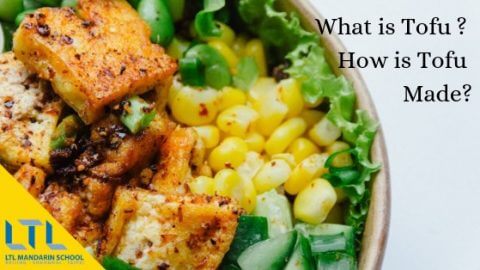
But what is tofu?
And how is tofu made?
Very logically tofu is literally named ‘bean’ (豆dòu) ‘fermented’ (腐 fu) in Chinese, as it is made from fermented soya beans.
In English it is can also be referred to as bean curd.
Discover Tofu – What is Tofu: The Legend of Tofu
Discover Tofu – How is Tofu Made?
Discover Tofu – Tofu Varieties
Discover Tofu – Popular Tofu Dishes in China
What is Tofu: The Legend of Tofu
The first tofu-making was recorded in China, at around the time of the Han dynasty, more than 2000 years ago.
The legend tells that Prince Liu An invented soy milk for his elderly mother.
She was ill and couldn’t chew her food. At her suggestion Liu An ground up some soya beans into milk, which is step one in tofu-making.
The invention of bean curd has also been attributed to Liu An himself.

As a devoted Daoist, Liu An spent a lot of time and money on discussions of how to attain sainthood and cultivate energy clusters known as Dan.
According to another legend Liu An produced soy milk as he believed it would help with keeping Dan.
One day the soy milk was accidentally mixed with gypsum powder and the first tofu-like substance was formed.
And is essentially answers our questions of what is tofu and how is tofu made.
However, some sources discredit this theory and claim that it was the group of monks with whom Liu An lived who taught him the tofu-making process.
These Chinese Daoists were said to know ‘alchemical’ methods used to make bean curd from soy milk.
As a fairly powerful person of the time, Liu An enabled increased production and propagation of soy milk and tofu, which made him famous for the products.
Bean curd didn’t become a widespread, popular food in China until the Song Dynasty (960AD – 1279AD).
It was generally only eaten in the winter before refrigeration was available in China as it spoiled too quickly in the warmer months.
Traditionally, it is used as a food offering to the deceased, because spirits are believed to have lost their jaws so can only eat very soft food.
The spread of tofu to different parts of East and SouthEast Asia is believed to be linked with the spread of Buddhism in the region, as it’s an important source of protein in the Buddhist vegetarian diet.
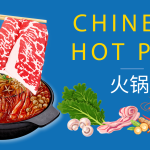
A Beginners Guide on How to Eat and Order Chinese Hot Pot
Chinese hot pot (火锅 huǒguō) literally means fire-pot. It’s history goes back over 1,000 years. It is one of the most traditional and popular meals in China.
HAVE YOU HEARD OF – Stinky Tofu? Find out more with our guide to stinky Chinese foods!
How is Tofu Made? Our Imprecise Guide to Tofu-making:
I recently signed up for a making-tofu-from-scratch class at the Hutong cooking school in Beijing, and it was a lot of fun.
Aside from generally being quite useless when it comes to cooking, I also had zero idea of how this mysterious but tasty substance is produced and my curiosity got the better of me.
So here’s a very rough explanation of what we did and how tofu is made.
1. Soak the beans
Luckily for us the Hutong had this side of things thoroughly prepared for us.
Usually when you buy soy beans from the local market/supermarket they’re dried.
You need to soak them in water overnight to re-hydrate them. Rinse them first.
2. Raw soy milkshake
Once the beans are fully rehydrated you need to mix them with even more water, this time in a blender.
Blend them as smooth as you can (the more powerful the blender they smoother this will be) to make a kind of milkshake like liquid.
3. Sieve out the pulp
The curd is made the from liquid parts only, so using a sieve and cheesecloth (this catches the really fine pulpy bits), separate the pure soy milk and pulp bits.
This part can get a little messy. Don’t throw away the pulp/tofu dregs, known in Chinese as doufuzha 豆腐渣.
This can make a really delicious veggie burger patty or ‘meat’ ball.
4. Cook the soy milk
Heat your raw soy milk up on a medium to low heat, stirring so it doesn’t boil over.
Now you have soy milk ready to drink! If you have a sweet tooth you can add sugar.
5. Magically turn the milk into tofu
This is a bit like the yoghurt-making process; you have the milk and you need to make it clump together.
We added spoonfuls of vinegar to do this, which acts as a coagulant to turn the soy milk, like magic, into tofu.
We had to add them carefully, one at a time to make sure we didn’t break up the curds.
Though there are several other things you can use as a coagulant, for example: lemon juice, epsom salts, gypsum, nigari are all quite commonly used.
6. Press your bean curds
Once your soy milk has turned into a tofu-like substance you can spoon it into a wooden basket, place a cloth and something heavy (like a bowl of water) on top.
This presses your tofu together and the excess water will leak out of the bottom of the basket.
And voila, you have a basket of fresh bean curd.

Drinking Hot Water – China’s Obsession, But What’s The Deal?
Drinking Hot Water in China is a huge thing and not just in the Winter! Where does China’s obsession with hot water come from though? We explain all…
Tofu Varieties
When I first came to China I was surprised by how many different things were translated into ‘tofu’ when I asked what I was eating.
Here’s a brief overview of some of our favourite foods that are ‘tofu’:
Soft or firm tofu:
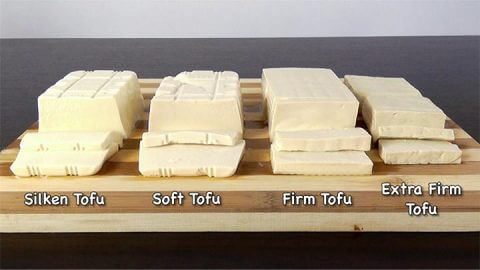
The texture of fresh bean curd ranges from silken to extra firm, with all the stages in between.
The main difference comes from how much water is pressed out of the tofu.
The firmer the tofu, the higher it will be in both protein and fat content.
There are also many other types of pre-prepared/partially cooked tofu products available
Deep-fried tofu:
Deep-fried bean curd cubes are crispy around the edges and soft-centred.
Tofu Skin:

This tastes much better than it sounds.
There are 3 main different types
- 腐竹 – bamboo tofu (named because it looks like bamboo)
- 油豆皮 – oily tofu skin
- 干豆皮 – dry tofu skin.
All three are made from the dried and cooked skin of the soy milk as it’s being turned into bean curd.
Dry Tofu 豆腐干 (dòufu gān):
A tasty, vegan alternative to smoked cheese, dry bean curd needs little to no preparation.
Frozen Tofu 冻豆腐 (dòngdòufu):
You can buy pre-frozen bean curd to add to hot pot and other yummy dishes.
It has a spongey texture when thawed out.
Fish Tofu:
A bit of a red herring in this list (excuse the pun).
Fish tofu is actually not tofu at all, it’s a starchy fish cube that has a tofu-like texture.
It usually does contain fish and soy bean oil.
Popular Tofu Dishes in China
Today many Chinese dishes contain bean curd; it has a subtle flavour and is used as both savoury and sweet dishes.
In case you don’t know where to start getting your tofu fix after all that, here are a few recommendations:
1. Mapo Tofu – 麻婆豆腐 (Má pó dòufu)
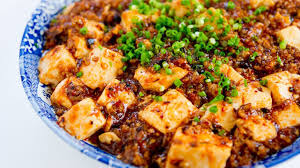
This is a delicious Sichuan dish of soft bean curd chunks.
It has lots of chilli and mouth-numbing Sichuan peppercorns.
It generally contains ground pork for flavouring, but the vegetarian alternative Mala tofu is also delicious.
It’s always good to check whether it contains meat when you order, just in case.
2. Drypot Tofu – 干锅豆腐 (Gān guō dòufu)
This is a member of the hotpot family without the soup base.
Different types of tofu can be used in this sort of dish, dry bean curd, bamboo bean curd, bean curd skin are all popular.
Additionally vegetables are often added to the mix.
3. Home-style Tofu – 家常豆腐 (jiācháng dòufu)
There are many home-style tofu recipes across China.
Said to be one of Chairman Mao’s favourite dishes, Hunan home-style bean curd is one of the most common across the province.
This dish is generally made with deep-fried tofu pieces, though often contains strips of pork, so be careful veggies.
Simple vegetables such as spring onions or leeks are also often added.
4. Stinky Tofu – 臭豆腐 (Chòu dòufu)
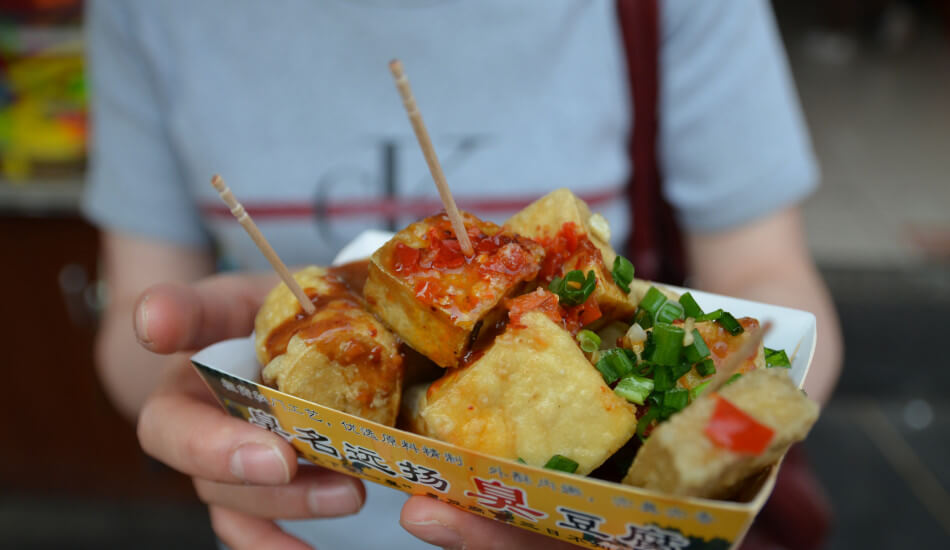
As the name suggests, you’ll probably smell this dish before you catch sight of it.
It is usually sold at street stalls and markets as a snack rather than a main dish in a restaurant.
There are lots of variations of this in mainland China, Hong Kong and Taiwan. One of the most famous is again Hunan-style.
The worse the smell, the better the flavour, so we’re told. You just have to get close enough to eat it to try this out.
5. Cold Marinated Bamboo Tofu – 凉拌腐竹 (Liángbàn fǔzhú)
These chewy bean curd sticks are marinated with vinegar, garlic and sesame oil.
It is often served with celery stalks, and is perfect for hot humid days when you want to eat something cold.
In case you missed it…
We’ve also written a blog about how to be vegetarian or vegan in China with some great recommendations for dishes.
Tofu also goes hand in hand with Chinese hot pot, check out our guide to eating Chinese hot pot also.
Please feel free to visit both of these blogs!
Tofu – FAQ’s
What is Tofu in Chinese?
Tofu in Chinese is 豆腐 dòufu – literally this means bean fermented.
Is Stinky Tofu real?
It is indeed and it’s everywhere in China.
Stinky tofu, or chòu dòufu (臭豆腐), is a type of tofu that is fermented in a special brine, which gives it a smelly funk that lives up to its name.
Do Chinese like Stinky Tofu?
Yes stinky tofu is super popular in China. In fact many believe “the smellier the better” – similarly to how many think regarding cheese!
What are some popular tofu dishes?
There really are a lot of popular tofu dishes in China but three really popular ones are:
Stinky Tofu – 臭豆腐 (Chòu dòufu)
Mapo Tofu – 麻婆豆腐 (Má pó dòufu)
Drypot Tofu – 干锅豆腐 (Gān guō dòufu)
Want more from LTL?
If you wish to hear more from LTL Mandarin School why not join our mailing list.
We give plenty of handy information on learning Chinese, useful apps to learn the language and everything going on at our LTL schools!
Sign up below and become part of our ever growing community!


 Hi, my name is Mojca! I am from Slovenia and I work as a student advisor at our Shanghai school.
Hi, my name is Mojca! I am from Slovenia and I work as a student advisor at our Shanghai school.








9 comments
How long will it keep ??
Hi Vicki,
After being opened shelf life is generally 3-5 days. Have you tried it before?
Regards
LTL Team
[…] vegetarians they also have an excellent crispy tofu burger, which they promise even tofu haters will […]
[…] can be incredibly inexpensive at around $3-4 for a very good meal of dumplings, tofu, or […]
[…] dishes were usually made from veggies, tofu, beans and rice. But development of a country is usually paralleled with meat […]
Never been a big fan but I want to like it. So versatile
Yes understand the feeling. I've been the same actually. Takes time to get used to it but there are many ways to enjoy Tofu for sure.
[…] staple in Chinese cooking we have tofu, this word has a Sino-Japanese origin, it comes from the Japanese 豆腐 tōfu, which […]
[…] is a platter of nutritious and tasty seafood along with proteins such as pork, poultry, and tofu. You will also enjoy the traditional dumplings, noodles, and wheat gluten are Shadong cuisine […]